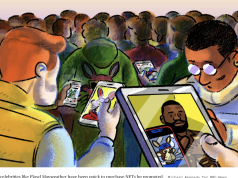Fortune, April 18th, 2022 DAN WALLACE-BREWSTER
Facebook’s re-brand into Meta has prompted most consumers to conceptualize the metaverse, but they thought it was still science fiction akin to the Matrix franchise or Ready, Player One.
Without the dystopian themes, they’re not far off. Both the “real-world” metaverse and its Hollywood depictions surround stationary role players operating in a digital environment without the limits of the physical world.
The seeds of a metaverse revolution were planted long ago, and the opportunity for growth is abundant in a commercial landscape now restricted by the burdens of rent, labor shortages, and broken supply chains: virtual pop-up shops or product drops don’t require travel, parking, or waiting in line.
For those who will still want a physical experience, stores are adapting their floorplans to be more interactive and immersive, rather than relying so heavily on the old retail models that have created a distaste for high resource consumption and fast fashion.
A paradigm shift
The future of retail is filled with possibilities, and retailers are conceptualizing what their “tomorrow” must look like to align themselves with this rapidly approaching future in the metaverse.
For example, the opportunity to expand a brand’s audience in the metaverse is dramatically increased. One person can make purchasing decisions as one or multiple distinctive virtual avatars and the value placed on virtual purchases may match or in some cases exceed that of real-world purchases.
With consumers taking on multiple personas, yesterday’s personalization algorithms may as well be rocks and sticks. Immersive and interactive content will become even more crucial to provide an authentic and inviting online retail environment for whoever that consumer happens to be that day in the metaverse.
Customers will expect the same quality experience whether they are interacting with a physical store associate, an influencer’s avatar in a pop-up shop, or a bot in their eCommerce store. Retailers will have to provide a seamless transaction, honor a wide range of cryptocurrencies, and deliver across both physical and digital mediums within a single transaction.
An ecosystem takes shape
Concepts consumers are already familiar with, such as subscription services, influencers, and virtual events, will find a way to adapt and grow within the metaverse.
The “subscription economy” is expected to double in size, growing to $1.5 trillion by 2025. So as the metaverse takes shape, subscription services will take shape within it.
Consumers will be able to subscribe to their favorite designers and influencers, and essentially live in that influencer’s virtual world alongside their own, trying-on clothes and experiencing “shopping hauls” through the influencer’s content as if the subscriber’s favorite YouTuber is in the next fitting room.
Subscription services could also include licensed designs from top fashion designers to wear in the virtual world. With advancements in 3D printing, it seems likely that digital designs will someday be produced at home, delivered instantly, and made to order.
The convergence of virtual and physical design has already paved the way for the mass production of 3D-printed footwear. As the technology becomes more accessible to the everyday consumer and aligns with the growth of the metaverse, we will soon see sneaker-heads 3D printing their footwear from home, sporting designs provided exclusively from top designers, licensed by subscribers, or purchased from fans in a virtual world, with the possibility for it to be brought to life in the physical one.
Growth in the metaverse promised to come incrementally until enough infrastructure, developers and users create a tipping point. With Facebook breaking new ground and proven taste-maker Apple following, that pivotal moment may be closer than ever.
As retail embraces an infinite suite of physical and digital goods and experiences, the rules are being written in real time–and shopping will never be the same again.









